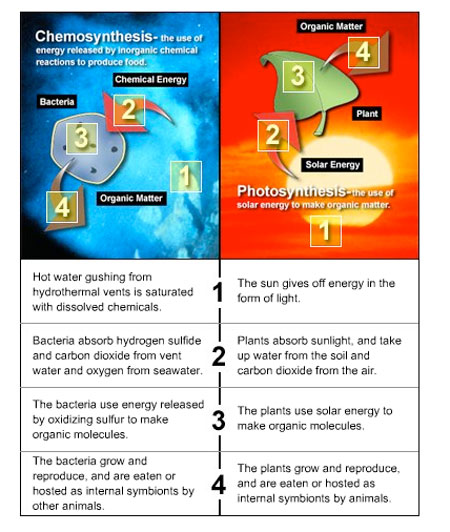Chemosynthesis vs. Photosynthesis
Ecosystems depend upon the ability of some organisms to convert inorganic compounds into food that other organisms can then exploit. In most cases, primary food production occurs in a process called photosynthesis, which is powered by sunlight. In a few environments, primary production happens though a process called chemosynthesis, which runs on chemical energy. Together, photosynthesis and chemosynthesis fuel all life on Earth.
The diagram below compares examples of these two processes - chemosynthesis in a seafloor hydrothermal vent bacterium, and photosynthesis in a terrestrial plant.

Additional Information
All photosynthetic organisms use solar energy to turn carbon dioxide and water into sugar and oxygen. There is only one photosynthetic formula:
6CO2 + 6H2O -> C6H12O6 + 6O2
Photosynthesis occurs in plants and some bacteria, wherever there is sufficient sunlight - on land, in shallow water, even inside and below clear ice.
All chemosynthetic organisms use the energy released by chemical reactions to make a sugar, but different species use different pathways. The vent bacteria used in the example above oxidize hydrogen sulfide, add carbon dioxide and oxygen, and produce sugar, sulfur, and water:
CO2 + 4H2S + O2 -> CH20 + 4S + 3H2O
Other bacteria make organic matter by reducing sulfide or oxidizing methane. Chemosynthetic bacterial communities have been found in hot springs on land, and on the sea floor around hydrothermal vents, cold seeps, whale carcasses, and sunken ships.
Related Links
Multimedia Discovery Missions: Lesson 5 - Chemosynthesis and Hydrothermal Vent Life

